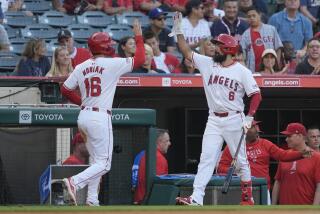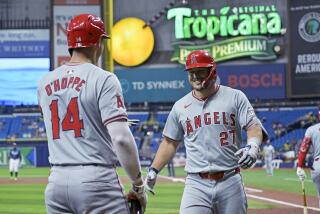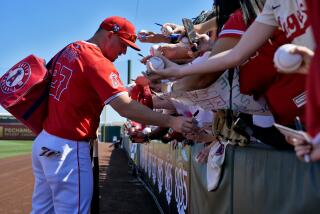BASEBALL 1992 PREVIEW : In â92, Itâs Almost Like Starting Over
Take one look at the Angelsâ 1992 lineup, for as long as one straight face can endure, and two words unfailingly come to mind.
Expansion team .
Old players nobody else wants. Young players nobody else wants. No speed. No power. No chance at a winning record. Good chance at 100 losses.
The Angels went through this once before, 31 years ago, in 1961. But that time, they had an excuse. That time, they really were an expansion team.
Maybe even a better team.
Compare the batting orders, 1961 and 1992, and draw your own conclusions. Buck Rodgers, given the choice, would no doubt draw a new hand.
Thirty-one years of progress, California Angel style:
First base: Steve Bilko (â61) or Lee Stevens (â92).
Bilko was the first Angel legend--a legend, in fact, before his first Angel game. The Mickey Mantle of the minor leagues, Bilko hit 55 Pacific Coast League home runs in 1956 and 56 more in â57, bringing âHome Run Derbyâ to L.A.âs old Wrigley Field years before television did.
Stevens hit 49 Pacific Coast League home runs. Total, for three Pacific Coast League seasons. Angel legend? Stevens replaces one, Wally Joyner, who replaced another, Rod Carew, six years earlier.
Bilko hit 20 home runs, drove in 59 runs and batted .279 in 1961. Stevens begins 1992 with a sore wrist.
Advantage: â61.
Second base: Ken Aspromonte (â61) or Bobby Rose (â92)
Aspromonte was a 29-year-old, three-year big league veteran by the time the Angels selected him in the 14th round of the expansion draft. In 1960, Aspromonte batted .288 with 48 RBIs for Washington and Cleveland. In â61, he hit .223 with 14 RBIs in 66 games before losing his job to Billy Moran.
Rose is 25, a veteran of 43 big league games in which he hit .267 with three home runs and 13 RBIs. He opens â92 as the most tentative of the eight Angel regulars. Waiting in the wings: Luis Sojo, last yearâs starter, and Kevin Flora, the fastest player in the organization.
Advantage: A push.
Third base: Eddie Yost (â61) or Gary Gaetti (â92)
They called Yost âThe Walking Man,â in reference to the best aspect of his game. Yost led the American League in walks six times, with a high of 151 in 1956. In â61, however, Yost walked only 50 times, largely because Manager Bill Rigney cut him off after 213 at-bats and a .202 batting average.
Gaetti, at 33, is âThe Once Sprinting Then Running Then Jogging And Now Walking Man.â His home run totals since 1986: 34, 31, 28, 19, 16 and 18. His RBI totals since 1986: 108, 109, 88, 75, 85 and 66. The good news: His 1991 batting average (.246) was up 17 points from 1990.
Advantage: â92.
Shortstop: Joe Koppe (â61) or Gary DiSarcina (â92)
Koppe played 88 games at shortstop for the expansion Angels, coming over from Philadelphia in an early-season minor league trade. He batted .251 with 40 RBIs and was the starter throughout the Angelsâ 45-44 second half.
DiSarcina is 24, a .310 hitter in Edmonton last year, a .212 hitter in Edmonton the year before, and the best thing the Angels can say about him is that heâs not Dick Schofield.
Advantage: â61.
Left field: Leon Wagner (â61) or Luis Polonia (â92)
Wagner hit 28 home runs in his first Angel season--or 15 more than Polonia has in five big league seasons. Wagnerâs game was power; he also drove in 79 runs that year. Poloniaâs game is singles and speed; heâs a .300 career hitter who stole 48 bases last season.
Defense? If youâve seen Luis, you donât have to ask about Leon.
Advantage: â61.
Center field: Ken Hunt (â61) or Junior Felix (â92)
Hunt was going nowhere in the Yankeesâ organization--someone named Mantle was playing center at the time--so New York left him unprotected in the expansion draft, and the Angels immediately made him a starter.
Hunt played 135 games, hit 25 home runs, had 29 doubles and knocked in 84 runs. In other words, the kind of season the Angels are still waiting to see from Felix.
Advantage: â61.
Right field: Albie Pearson (â61) or Von Hayes (â92)
Pearson was no home run hitter; he had only 28 during a nine-year major league career. But at least there was no pretense. Hayes used to be a home run hitter--he had 26 in 1989--but didnât hit any last year and hasnât hit one in 336 at-bats, a streak that wasnât tainted by anything that happened this March in Arizona and Palm Springs.
Pearson did, however, hit for average, batting .288 in 1961. Hayesâ averages since 1989: .259, .261, .225.
Advantage: â61.
Catcher: Earl Averill (â61) or Lance Parrish/John Orton/Ron Tingley/Mike Fitzgerald (â92)
Averill begins with one big edge over Parrish: The Angels wanted him to be their catcher. His numbers for â61 (.266, 21 home runs, 59 RBIs) also beat Parrishâs â91 figures (.216, 19, 51) across the board.
If Parrish is on the way out, no Johnny Bench is on the way in. Johnnys On The Bench, maybe. Orton, Fitzgerald and Tingley are all card-carrying members of the .200-And-Change Club. In order, they batted .203, .202 and .200 in 1991.
Advantage: â61.
Designated hitter: Ted Kluszewski (â61) or Hubie Brooks (â92)
There was no designated hitter in 1961, but we wanted to give the â92 crew every break in the book, so we nominated Rigneyâs top pinch-hitter and threw him against Brooks, â92âs major off-season acquisition.
Sorry about that.
At 36, in his final season, Big Klu hit 15 home runs in 263 at-bats. Brooks hit 16 home runs last season, but that was before he turned 35 and underwent spinal surgery.
Advantage: â61.
Footnote: The 1961 Angels went 70-91 and finished 38 1/2 games out of first. Granted, the 1992 Angels have superior pitching, but the 1992 Angels also donât have to play 18 games against the â61 Yankees.
Lose Chuck Finley, Mark Langston or Jim Abbott to any kind of injury, for any amount of time, and that 70-91 is going to look like a shining brass ring.
More to Read
Go beyond the scoreboard
Get the latest on L.A.'s teams in the daily Sports Report newsletter.
You may occasionally receive promotional content from the Los Angeles Times.






